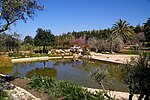Latrun

Latrun (Hebrew: לטרון, Latrun; Arabic: اللطرون, al-Latrun) is a strategic hilltop in the Latrun salient in the Ayalon Valley, and a depopulated Palestinian village. It overlooks the road between Tel Aviv and Jerusalem, 25 kilometers west of Jerusalem and 14 kilometers southeast of Ramla. It was the site of fierce fighting during the 1948 war. During the period of 1949–1967, it was occupied by Jordan at the edge of a no man's land between the armistice lines. In the 1967 war, it was occupied by Israel. The hilltop includes the Latrun Abbey, Mini Israel (a park with scale models of historic buildings around Israel), The International Center for the Study of Bird Migration (ICSBM), the Yad La-Shiryon memorial to armored corps soldiers killed in action, and military tank museum. Neve Shalom (Oasis of Peace) is a joint Jewish-Arab community on a hilltop south of Latrun. Canada Park is nearby to the east.
Excerpt from the Wikipedia article Latrun (License: CC BY-SA 3.0, Authors, Images).Latrun
Israel Trail, Mate Yehuda Regional Council
Geographical coordinates (GPS) Address Nearby Places Show on map
Geographical coordinates (GPS)
| Latitude | Longitude |
|---|---|
| N 31.831944444444 ° | E 34.981388888889 ° |
Address
Israel Trail
Mate Yehuda Regional Council
Jerusalem District, Israel
Open on Google Maps











